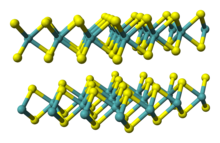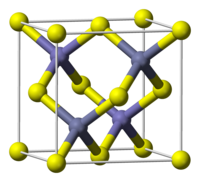Chalcogenide
A chalcogenide is a chemical compound consisting of at least one
Alkali metal and alkaline earth chalcogenides
Alkali metal and alkaline earth monochalcogenides are salt-like, being colourless and often water-soluble. The sulfides tend to undergo hydrolysis to form derivatives containing bisulfide (SH−) anions. The alkali metal chalcogenides often crystallize with the antifluorite structure and the alkaline earth salts in the sodium chloride motif.
Transition metal chalcogenides
Transition metal chalcogenides occur with many stoichiometries and many structures.[2] Most common and most important technologically, however, are the chalcogenides of simple stoichiometries, such as 1:1 and 1:2. Extreme cases include metal-rich phases (e.g. Ta2S), which exhibit extensive metal-metal bonding,[3] and chalcogenide-rich materials such as Re2S7, which features extensive chalcogen-chalcogen bonding.
For the purpose of classifying these materials, the chalcogenide is often viewed as a dianion, i.e.,
Metal-rich chalcogenides

In most of their chalcogenides, transition metals adopt oxidation states of II or greater. Nonetheless, several examples exist where the metallic atoms far outnumber the chalcogens. Such compounds typically have extensive metal-metal bonding.[5]
Monochalcogenides
Metal monochalcogenides have the formula ME, where M = a transition metal and E = S, Se, Te. They typically crystallize in one of two motifs, named after the corresponding forms of
Important monochalcogenides include some pigments, notably cadmium sulfide. Many minerals and ores are monosulfides.[1]
Dichalcogenides

Metal dichalcogenides have the formula ME2, where M = a transition metal and E = S, Se, Te.[7] The most important members are the sulfides. They are always dark diamagnetic solids, insoluble in all solvents, and exhibit semiconducting properties. Some are superconductors.[8]
In terms of their electronic structures, these compounds are usually viewed as derivatives of M4+, where M4+ = Ti4+ (d0 configuration), V4+ (d1 configuration), Mo4+ (d2 configuration).
Transition metals
Transition metal dichalcogenides typically adopt either
In contrast to classical metal dichalcogenides,
Tri- and tetrachalcogenides
Several metals, mainly for the early metals (Ti, V, Cr, Mn groups) also form trichalcogenides. These materials are usually described as M4+(E22−)(E2−) (where E = S, Se, Te). A well known example is niobium triselenide. Amorphous MoS3 is produced by treatment of tetrathiomolybdate with acid:
- MoS42− + 2 H+ → MoS3 + H2S
The mineral patrónite, which has the formula VS4, is an example of a metal tetrachalcogenide. Crystallographic analysis shows that the material can be considered a bis(persulfide), i.e. V4+,(S22−)2.[2]
Main group chalcogenides

As2S3 is a crosslinked polymer where the As and S centers obey the octet rule.
Chalcogen derivatives are known for all of the
The chalcogen is assigned positive oxidation states for the halides, nitrides, and oxides.
See also
- Carbon dichalcogenide
- Chalcogen
- Chalcogenide glass
- Hydrogen chalcogenide
- Negative resistance
- Phase-change memory
References
- ^ ISBN 0-7506-3365-4.
- ^ ISBN 0-521-21489-0.
- .
- .
- .
- ISBN 0-939950-01-4
- ISBN 0-19-855370-6.
- ^ a b Wood, Charlie (2022-08-16). "Physics Duo Finds Magic in Two Dimensions". Quanta Magazine. Retrieved 2022-08-22.
External links
- Advanced Chalcogenide Technologies and Applications Lab ACTAlab Jun 14, 2016
- Phase change memory-based 'moneta' system points to the future of computer storage ScienceBlog Jun 03, 2011
- Kovalenko, Maksym V.; Scheele, Marcus; Talapin, Dmitri V. (2009). "Colloidal Nanocrystals with Molecular Metal Chalcogenide Surface Ligands". Science. 324 (5933): 1417–1420. S2CID 21845356.
- Big Blue boffins hatch dirt-cheap solar cells The Register, 12 February 2010



